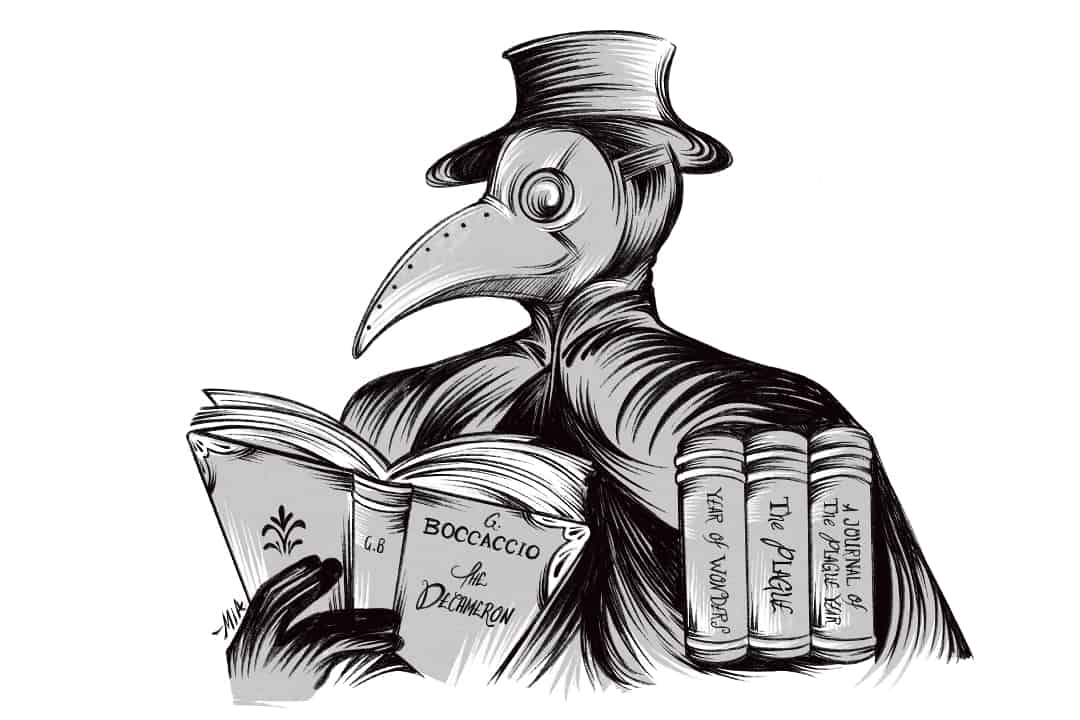Since the COVID-19 pandemic began, public interest in plague literature like Albert Camus’ novel The Plague has skyrocketed.
With this renewed interest has come discoveries of parallels between books from decades or centuries ago and our current situation. It’s worth asking what purpose plague literature can serve and what it can teach us about our circumstances.
In response to these questions, academic programs director at Victoria College and former English professor Ira Wells argued that “plague literature serves to remind us of a radical vulnerability in the face of the unknown.”
Wells wrote, “Despite all of our medical and scientific advances, there is an invisible world that we do not understand.”
He continued by writing that “the ‘plague’ in plague literature is real, but it also stands for the radical uncertainty in which all human life must endure.”
While reminding us of our vulnerability, plague literature can provide a reference for us to examine how we face uncertainty.
Confronting human behaviour in the face of plagues
There are a multitude of ways that authors choose to spin their tales on pandemics. Renowned authors from different times have taken their turn at writing about plagues, leaving behind valuable works that are still being read today.
From Giovanni Boccaccio’s classic Italian prose novel The Decameron to more modern historical fiction novels such as Year of Wonders by Geraldine Brooks, these works of literature all share the ability to offer us insight on people’s behaviour when they are faced with an unknown and frightening situation.
A classic work of plague literature is Daniel Defoe’s A Journal of the Plague Year. This novel is an account of the bubonic plague in London. Wells cited this book as one he’ll never forget reading, noting that the “visceral scenes of horror” that the novel includes are memorable.
Defoe does indeed often conjure up graphic images in A Journal of the Plague Year, writing about fear and panic overrunning the city. He describes affluent people fleeing the city while those affected by poverty have nowhere to go, and people taking advantage of the fear to try to sell useless concoctions that supposedly protect against the plague.
Defoe’s parallels with COVID-19
Wells points out a “contemporary parallel” about quarantine in Defoe’s novel and the current situation about how people are growing restless and unhappy due to the restrictions being placed on them.
“As the philosopher Giorgio Agamben has recently (and controversially) illustrated, a vigorous government public health response may be interpreted as authoritarian overreach or even a form of biopolitics,” Wells wrote.
He continued, “Our efforts to contain the virus may be necessary; they may also breed unintended consequences. We may need our own Defoe to tell that story 50 years from now.”
However, Defoe does not mean to solely condemn the entire city. For instance, when he speaks of how there are always enough volunteers to bury those killed by the plague, he writes, “It was never to be said of London that the living were not able to bury the dead.”
Defoe also aims to point out the resilience that the city displayed and to commend acts of heroism and kindness that took place throughout the bubonic plague.
Camus’ selfishness and altruism
Another prominent example of literature about plagues is the novel The Plague, published in 1947 by Camus. In The Plague, Camus writes about an Algerian town where the bubonic plague struck.
When faced with disaster and looming death, how do Camus’ characters react? Unfortunately, there are some who fail to rise to the occasion. They are unable to see the need to consider the effect of their actions on others, and they fail to recognize that their selfish choices can have dire consequences on the lives of others.
At the same time, in contrast to the bad that a pandemic can bring out in people, Camus also highlights the altruism that can occur. He writes, “What’s true of all the evils in the world is true of plague as well. It helps men to rise above themselves.”
Despite the prevailing hopelessness and difficulties that plague the novel, Camus, much like Defoe, emphasizes that the good outweighs the bad.
Although the plagues in novels such as A Journal of the Plague Year and The Plague are far behind us, our generation has a new disease that has completely changed and will continue to alter the way we live for the foreseeable future.
Wells cautioned that “the vaccine for COVID-19 will arrive, but the plague will go on.” He wrote, “That may sound unbearably depressing, but it doesn’t have to be.”
Authors like Defoe and Camus did not diminish the horrors that people can commit during a plague, but they also sought to emphasize the good in people.
While we cannot control the virus itself, we can look to plague literature and realize that we are in control of how we react to the situation, which could very much be a positive thing. In the words of Camus, “to state quite simply we learn in times of pestilence: that there are more things to admire in men than to despise.”


